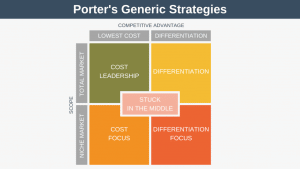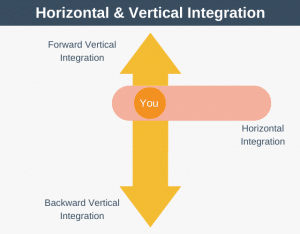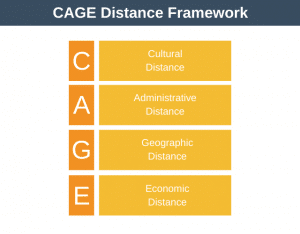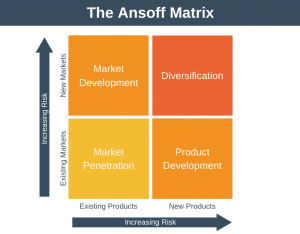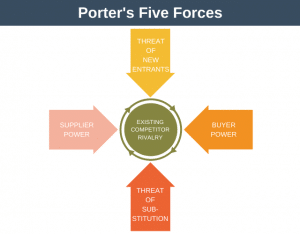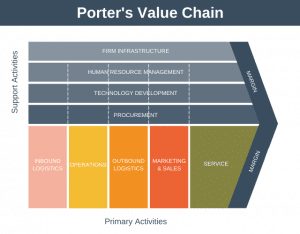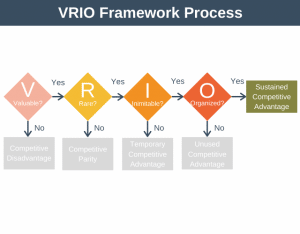SOAR analysis is a strategic planning tool that can be used to help your organization create and execute its strategy.
SOAR analysis works by focusing on your strengths and how they can be leveraged to take advantage of the opportunities facing your organization.
The tool isn’t something you would use on your own; instead, you would use it as a group in a team brainstorming session.
SOAR is an acronym standing for Strengths, Opportunities, Aspirations, and Results. Strengths and opportunities focus on your present situation, whereas aspirations and results focus on your desired future situation.
“Alternative Strategy Tools
SOAR Analysis is just one of a whole suite of strategy tools organizations use to help them create and articulate their strategy.
Some of the more commonly used tools include:
A SOAR analysis is drawn as a two by two matrix.
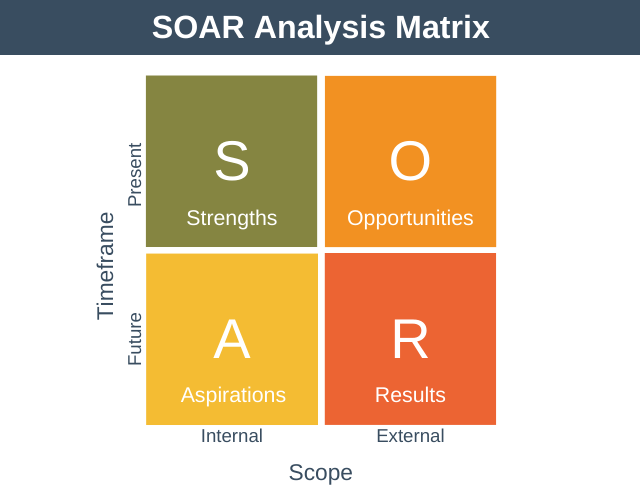
As you can see, the top row on the matrix focuses on the present, and the bottom row focuses on your desired future. The left column focuses on internal factors, and the right column focuses on factors that are external to your organization.
You might ask, why are results external and not internal? After all, don’t we achieve our own results? The answer is that results are considered an external factor as they are not something you achieve on your own. For example, your customers must be happy, and they must refer others to buy from you.
Let’s examine each element of a SOAR analysis in more detail.
1. Strengths
This section aims to determine the strengths of your organization that you can leverage and build on to seize the opportunities you decide to pursue.
This will take the form of a list and include your organization’s critical assets, resources, and knowhow.
Some questions that can help you determine your strengths include:
- What makes us unique?
- What is our unique selling point (USP)?
- What can we do (our most valuable knowhow) that is better than anyone else?
- What do we have (our most valuable assets) that are better than anyone else?
- Out of all our strengths, which is the most valuable in the marketplace?
2. Opportunities
This section of the SOAR analysis aims to identify the opportunities in the marketplace that you could pursue to become more successful.
Some questions that can help you identify opportunities in the marketplace include:
- What trends are happening in our market that we could leverage?
- What trends are happening in the wider world that we could leverage?
- Could any of the threats to our business be turned into an opportunity?
- Are there any gaps in our existing market?
- Are there any new markets we should enter?
- Do our customers have unfulfilled wants that we could meet?
3. Aspirations
This section aims to identify your aspirations for the future. It’s essentially a vision built on the strengths and opportunities you’ve identified to both challenge and inspire your organization to achieve.
Note that your aspirations are not the same as your organization’s overall vision. Your aspirations will typically be nearer-term in nature. For example, your company vision might be to be the biggest global airline, but your next aspiration might be to become the biggest airline within the single country you currently operate in.
Questions that can help you set your aspirations include:
- What should our future organization look like?
- What do we care genuinely about?
- How can we make a difference?
- What do we want to achieve?
- What should our goals be as an organization?
4. Results
This section aims to show how you will know that you have achieved your aspirations, and also outline how you intend to track progress towards your ambitions.
Goals setting techniques such as SMART goal setting and Outcome goal setting can be helpful here.
It is important not to set too many measures to track, instead measure the 3-5 values that are critical to business success. A balanced scorecard can be a useful tool in helping you track progress.
Some questions that can help you set your results include:
- How will we know when we have achieved our aspirations?
- What numbers/statistics can we use to measure our progress towards our aspirations?
- Can we translate our aspiration into something measurable?
- How and when will we track progress towards our aspirations?
Difference Between SWOT Analysis and SOAR Analysis
The key difference between a SWOT analysis and a SOAR analysis is that while a SWOT analysis scans your internal and external environment, it doesn’t help you figure out how to proceed. In contrast, a SOAR analysis helps you determine the results you want to achieve in the future.
Another difference is that a SOAR analysis doesn’t examine negatives, whereas a SWOT analysis will expressly look for threats and weaknesses. SOAR focuses on enhancing what is already being done well instead of addressing weak areas. Another way to say this is that a SOAR analysis focuses more on planting seeds than pulling weeds.
How to Perform a SOAR Analysis
A SOAR analysis is best performed as a group exercise with key stakeholders. Use the following six-step process to help you perform your SOAR analysis.
Step 1: Determine objectives
Determine why you are performing the SOAR analysis and what you hope to achieve. Determine the timeframe within which you want to achieve the results.
Step 2: Create a team
Put together the team that will brainstorm ideas. Include people from all levels of the organization and important external stakeholders, if possible.
Ask each stakeholder to complete an initial questionnaire to gather their initial thoughts on strengths, opportunities, aspirations, and results. These will form a key input into the brainstorming session.
Step 3: Brainstorm
Brainstorm and complete the first draft of your SOAR analysis as a team.
Step 4: Prune
Prune and trim your SOAR analysis so that only the most important aspirations and results remain. Basically, you need to decide which are the most attractive opportunities you want to pursue.
Once you have done this create your compelling and challenging vision of the future and determine how you will measure success (your results).
Step 5: Execute
Once your SOAR analysis is complete and approved, you need to delegate tasks to be executed. Each task identified in your SOAR analysis should have a single person ultimately responsible for it.
Step 6: Monitor
You need to track progress regularly. If you don’t do this, then how will you know you are making progress towards your aspirations and the results you want to achieve.
SOAR Analysis Template
We have created a SOAR Analysis Template in PDF format, which you can use to perform your own SOAR analysis. You can download it here.
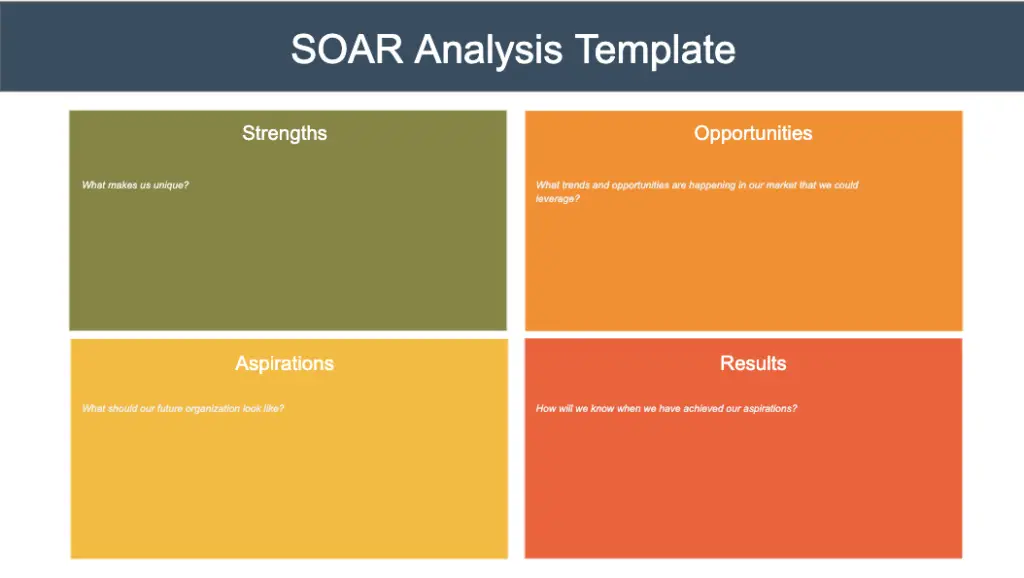
Advantages and Disadvantages
The main advantages of a SOAR analysis are:
- It doesn’t just analyze your situation but helps you set goals and targets to achieve.
- It’s forward-looking and positive, unlike SWOT, which spends 50% of its time encouraging you to fix weaknesses and threats.
- SOAR analysis is better than SWOT analysis for startups because the organization is so new it doesn’t know its strengths, weaknesses, or threats yet.
- It is action-oriented.
The main disadvantages of a SOAR analysis are:
- Aspirations are somewhat redundant because you’ll already have this stated as your organization’s vision.
- Although it builds on your strengths, it doesn’t do an in-depth analysis of the marketplace or your customers. This could lead you to focus on the wrong thing.
Summary
A SOAR analysis is an acronym standing for Strengths, Opportunities, Aspirations, and Results.
It’s a strategic planning tool that can help you identify opportunities that align with the strengths of your organization. Once you’ve done this, it enables you to create an action plan so you can bridge the gap between where you are now and where you want to be.

